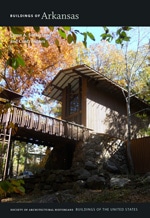John and Emily Drennen came to Arkansas in 1820. He was a cofounder of Van Buren and served as an Indian agent. The Drennens’ house, which overlooks the Arkansas River, started as a one-room log cabin and gained many single-story additions over the years, including a long porch with Eastlake detailing. The house passed down through the family (the Drennens’ daughter married Charles Scott) until purchased by the University of Arkansas at Little Rock. Restored, the house was opened to the public in 2011. Since then the Greek Revival Wilhauf House has been added to the historic site, and a visitor center was built.
You are here
Drennen-Scott House Historical Museum
1834–1836; later additions; 2011 restored, John Milner Associates. N 3rd St., north of Washington St.
If SAH Archipedia has been useful to you, please consider supporting it.
SAH Archipedia tells the story of the United States through its buildings, landscapes, and cities. This freely available resource empowers the public with authoritative knowledge that deepens their understanding and appreciation of the built environment. But the Society of Architectural Historians, which created SAH Archipedia with University of Virginia Press, needs your support to maintain the high-caliber research, writing, photography, cartography, editing, design, and programming that make SAH Archipedia a trusted online resource available to all who value the history of place, heritage tourism, and learning.















